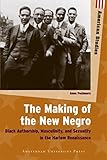The Making of the New Negro : Black Authorship, Masculinity, and Sexuality in the Harlem Renaissance / Jacques Thomassen, Anna Pochmara; ed. by Vanja Stenius, Lena Tsipouri.
Material type: TextSeries: American StudiesPublisher: Amsterdam : Amsterdam University Press, [2012]Copyright date: ©2011Description: 1 online resource (280 p.) : 18 halftonesContent type:
TextSeries: American StudiesPublisher: Amsterdam : Amsterdam University Press, [2012]Copyright date: ©2011Description: 1 online resource (280 p.) : 18 halftonesContent type: - 9789089643193
- 9789048514236
- 810.9896073
- online - DeGruyter
| Item type | Current library | Call number | URL | Status | Notes | Barcode | |
|---|---|---|---|---|---|---|---|
 eBook
eBook
|
Biblioteca "Angelicum" Pont. Univ. S.Tommaso d'Aquino Nuvola online | online - DeGruyter (Browse shelf(Opens below)) | Online access | Not for loan (Accesso limitato) | Accesso per gli utenti autorizzati / Access for authorized users | (dgr)9789048514236 |
Browsing Biblioteca "Angelicum" Pont. Univ. S.Tommaso d'Aquino shelves, Shelving location: Nuvola online Close shelf browser (Hides shelf browser)

|

|

|

|

|

|

|
||
| online - DeGruyter Market Oversight Games / | online - DeGruyter Postcolonial Netherlands : Sixty-Five Years of Forgetting, Commemorating, Silencing / | online - DeGruyter New Mythological Figures in Spanish Cinema : Dissident Bodies under Franco / | online - DeGruyter The Making of the New Negro : Black Authorship, Masculinity, and Sexuality in the Harlem Renaissance / | online - DeGruyter Space and the Production of Cultural Difference among the Akha Prior to Globalization : Channeling the Flow of Life / | online - DeGruyter A Risky Business? / | online - DeGruyter Attached to the World : On the Anchoring and Strategy of Dutch Foreign Policy / |
Frontmatter -- Table of contents -- Acknowledgements -- Introduction -- Chapter 1. Prologue: The Question of Manhood in the Booker T. Washington-W.E.B. Du Bois Debate -- Part 1. Alain Locke and the New Negro -- Chapter 2. Midwifery and Camaraderie: Alain Locke’s Tropes of Gender and Sexuality -- Chapter 3. Arts, War, and the Brave New Negro: Gendering the Black Aesthetic -- Part 2. Wallace Thurman and Niggerati Manor -- Chapter 4. Gangsters and Bootblacks, Rent Parties and Railroad Flats: Wallace Thurman’s Challenges to the Black Bourgeoisie -- Chapter 5.17 Discontents of the Black Dandy -- Chapter 6. Epilogue: Richard Wright’s Interrogations of the New Negro -- Conclusion. Black Male Authorship, Sexuality, and the Transatlantic Connection -- Notes -- Bibliography -- Index -- Curriculum Vitae
restricted access online access with authorization star
http://purl.org/coar/access_right/c_16ec
The Making of the New Negro examines black masculinity in the period of the Harlem Renaissance, a cultural movement that spanned the 1920s and 1930s in America and was marked by an outpouring of African American art, music, theater and literature. The Harlem Renaissance, or New Negro Movement, began attracting extensive academic attention in the 1990s as scholars discovered how complex, significant, and fascinating it was. Drawing on African American texts, archives, unpublished writings, and contemporaneous European discourses, this book highlights both the canonical figures of the New Negro Movement and African American culture such as W. E. B. Dubois, Booker T. Washington, Alain Locke, and Richard Wright, and other writers such as Wallace Thurman, who have not received as much scholarly attention despite their significant contributions to the movement. Anna Pochmara offers a striking combination of thorough literary analysis and historicist investigation in order to provide novel insights into one of the most important periods of black history in the United States.
Mode of access: Internet via World Wide Web.
In English.
Description based on online resource; title from PDF title page (publisher's Web site, viewed 01. Dez 2022)


